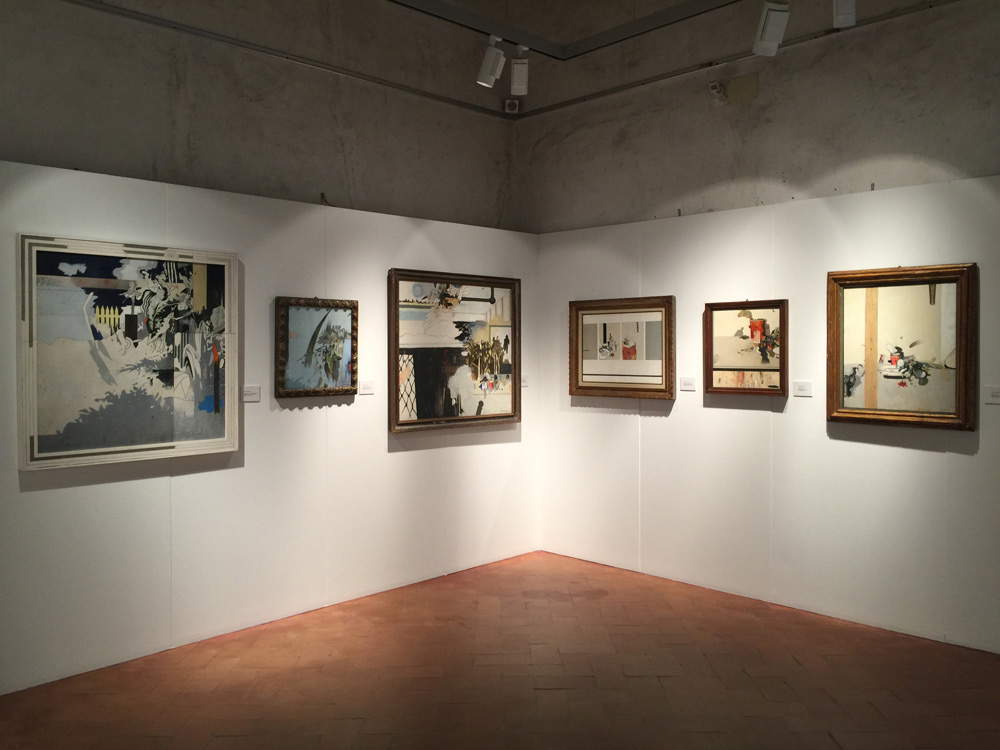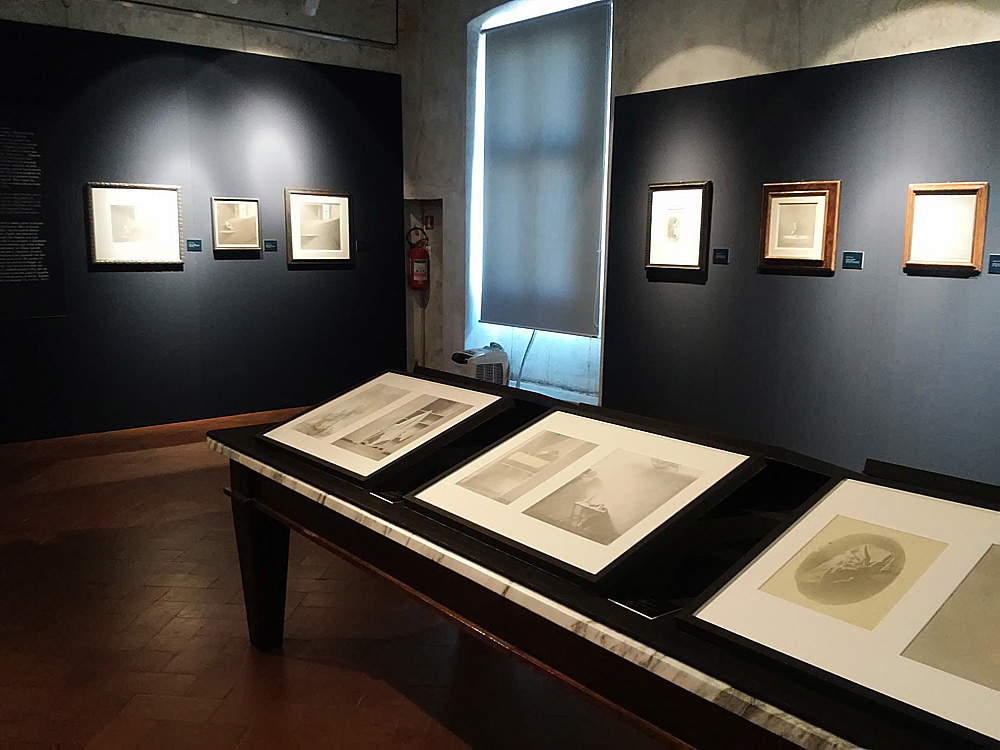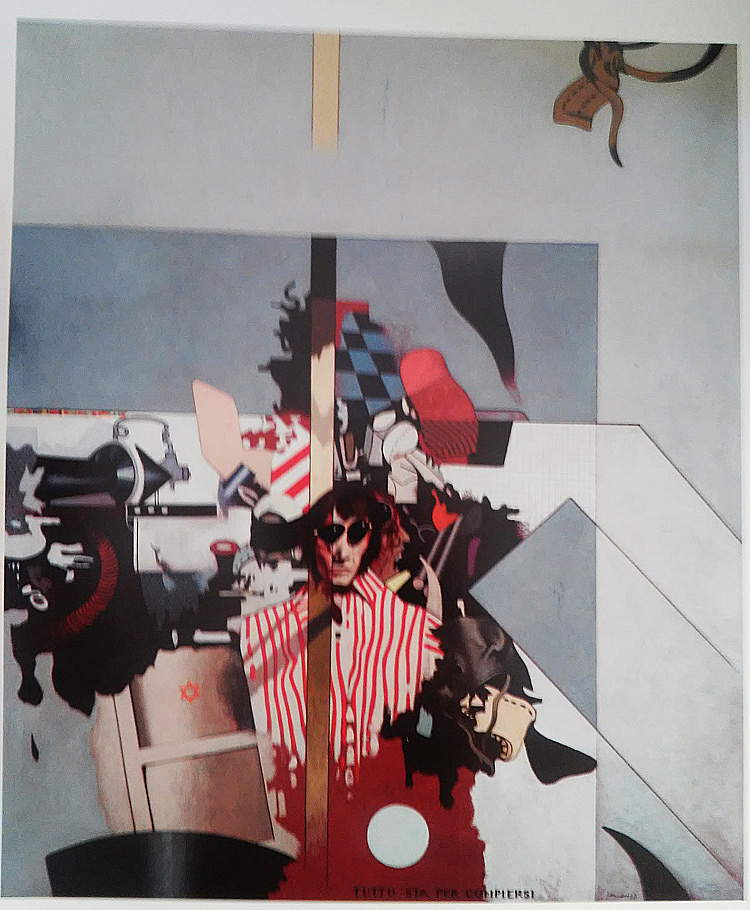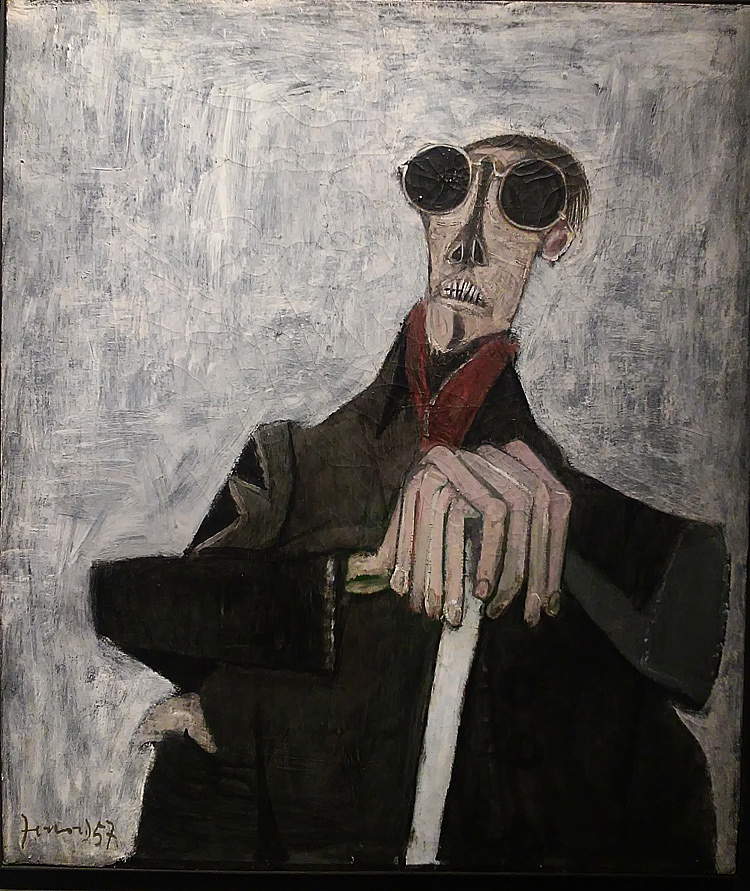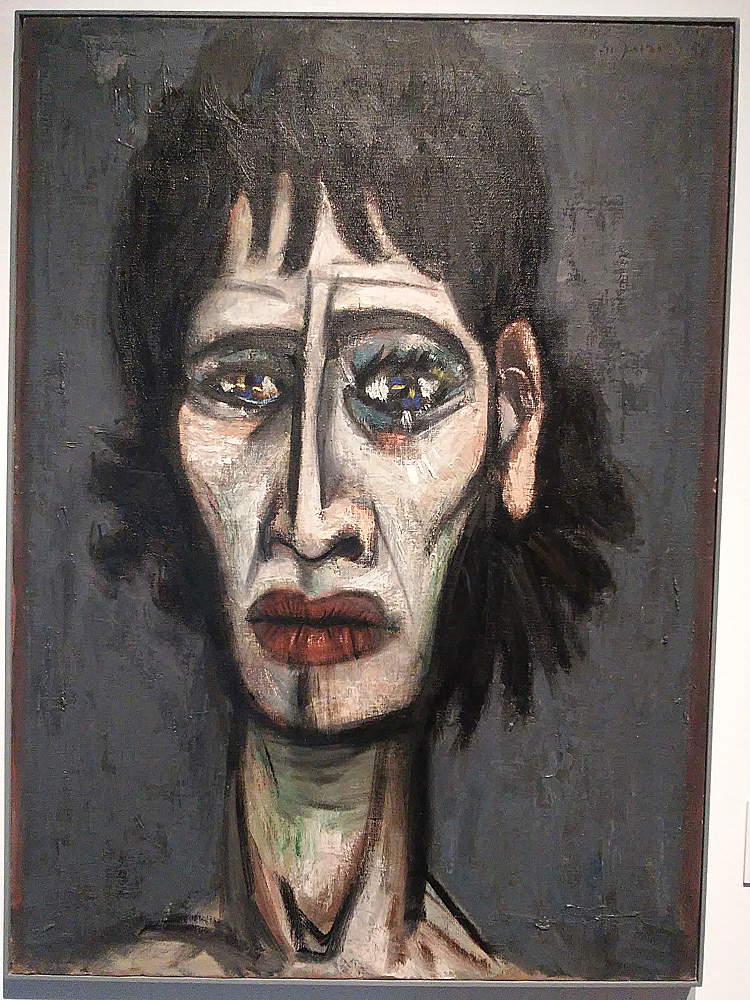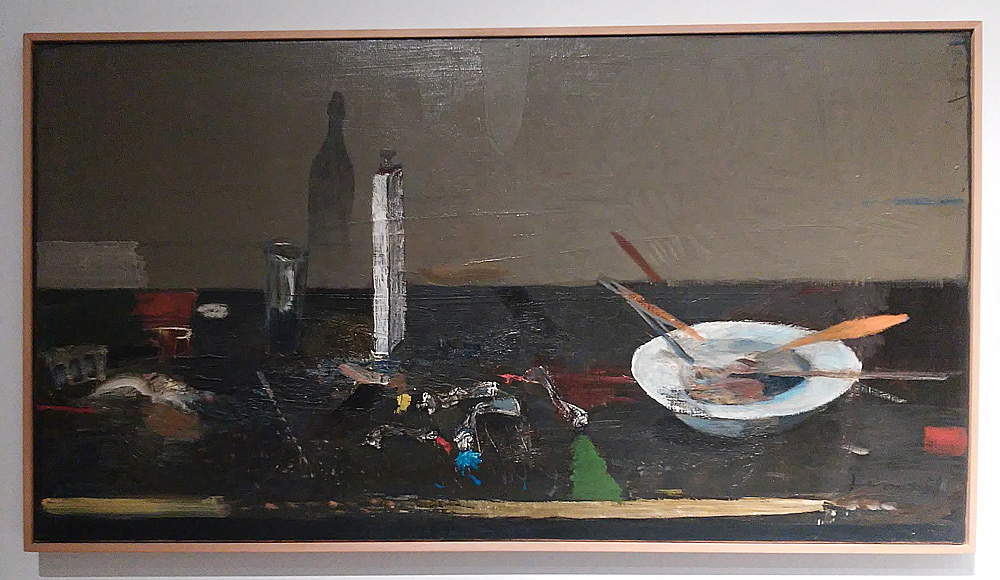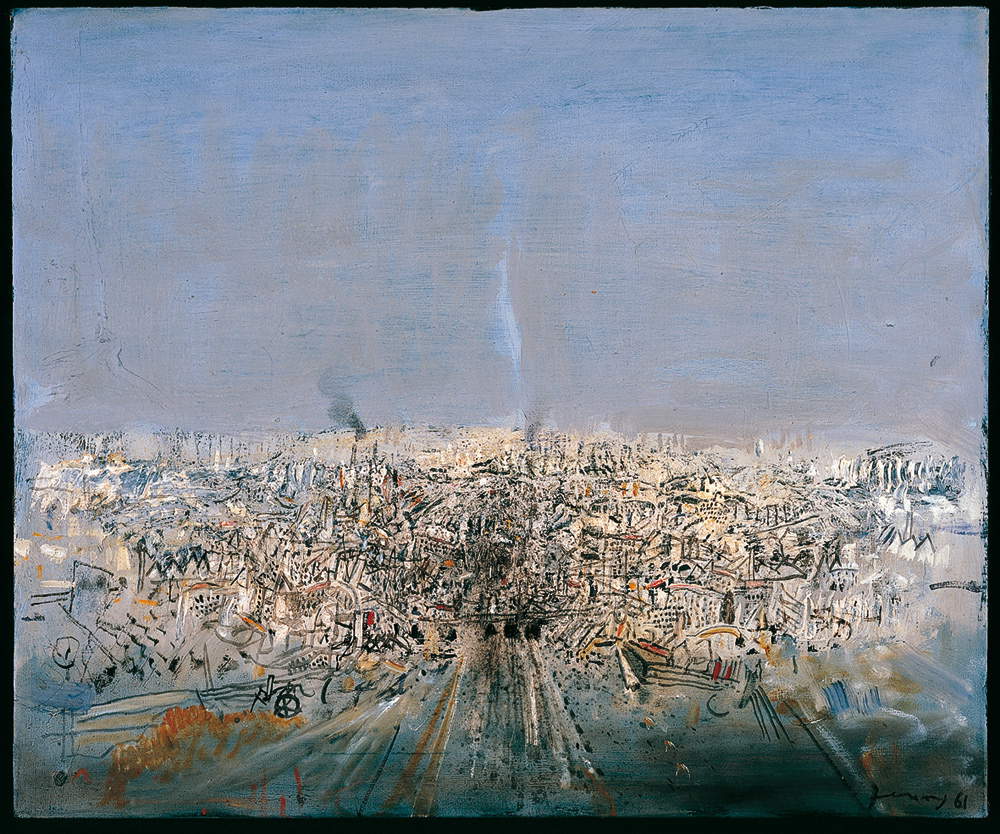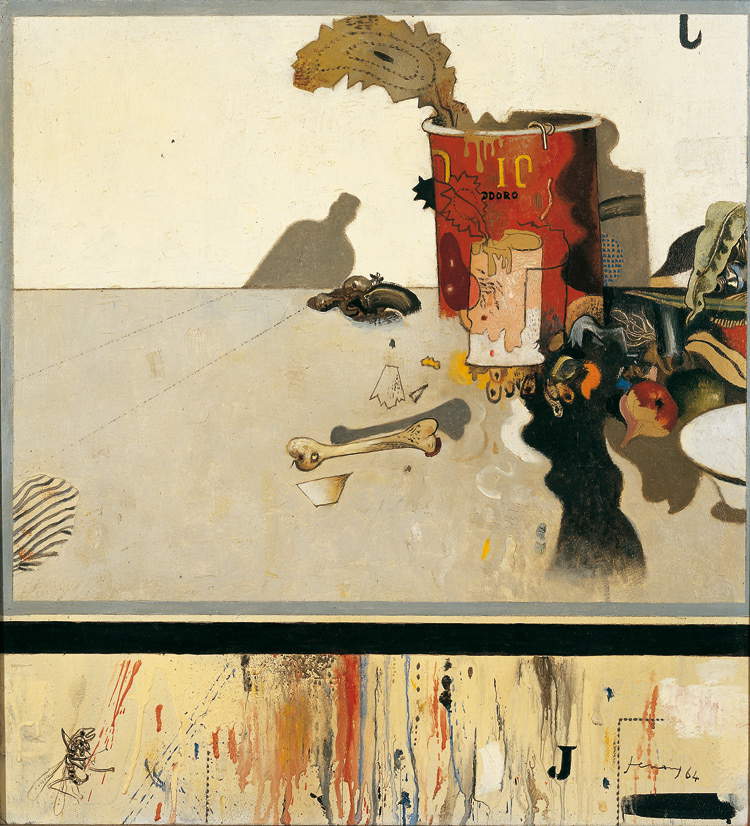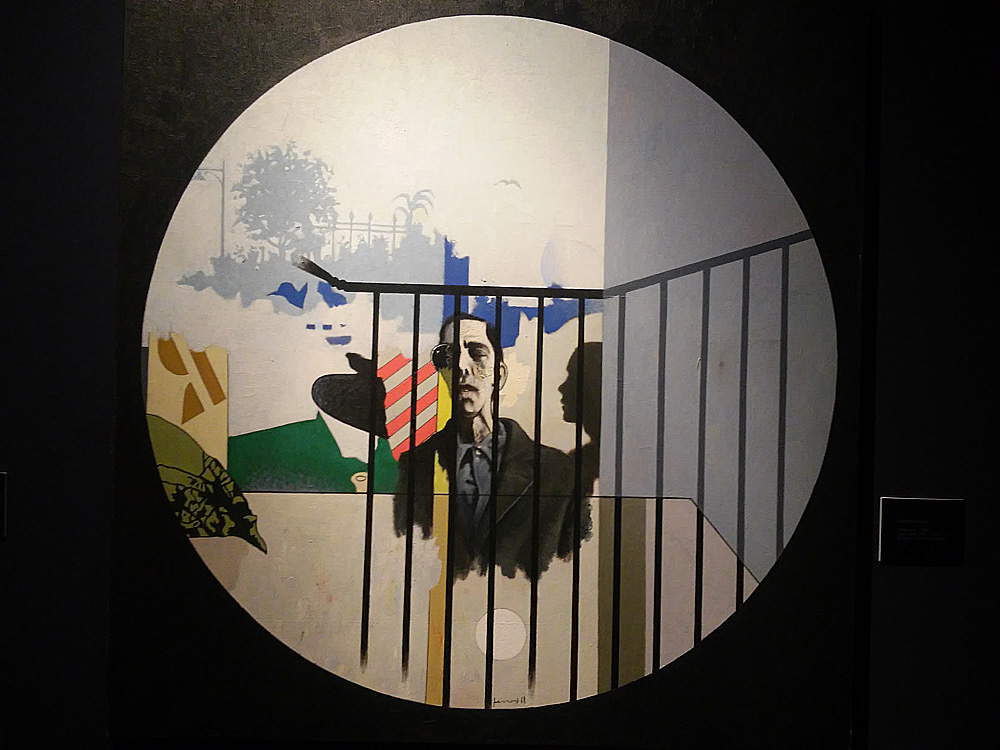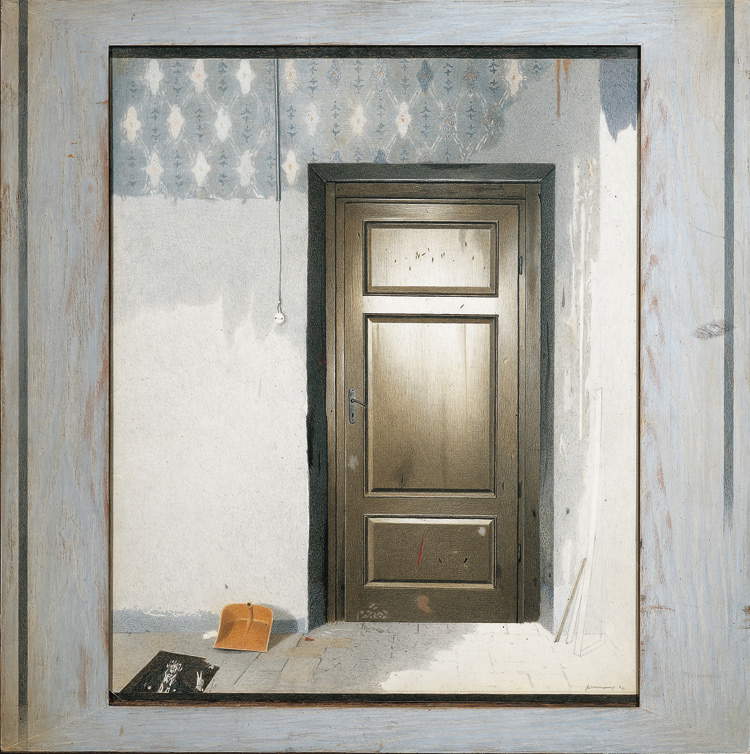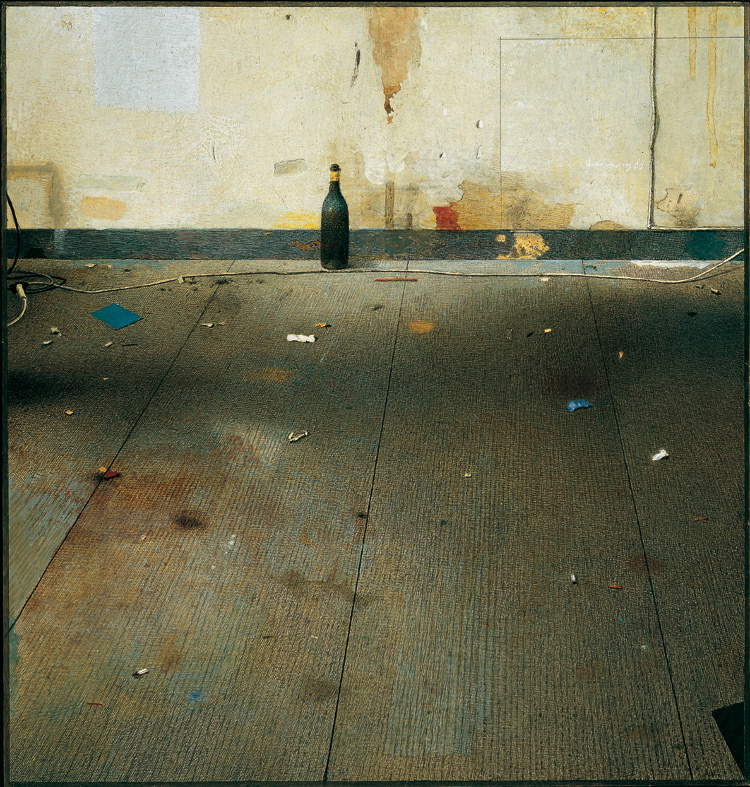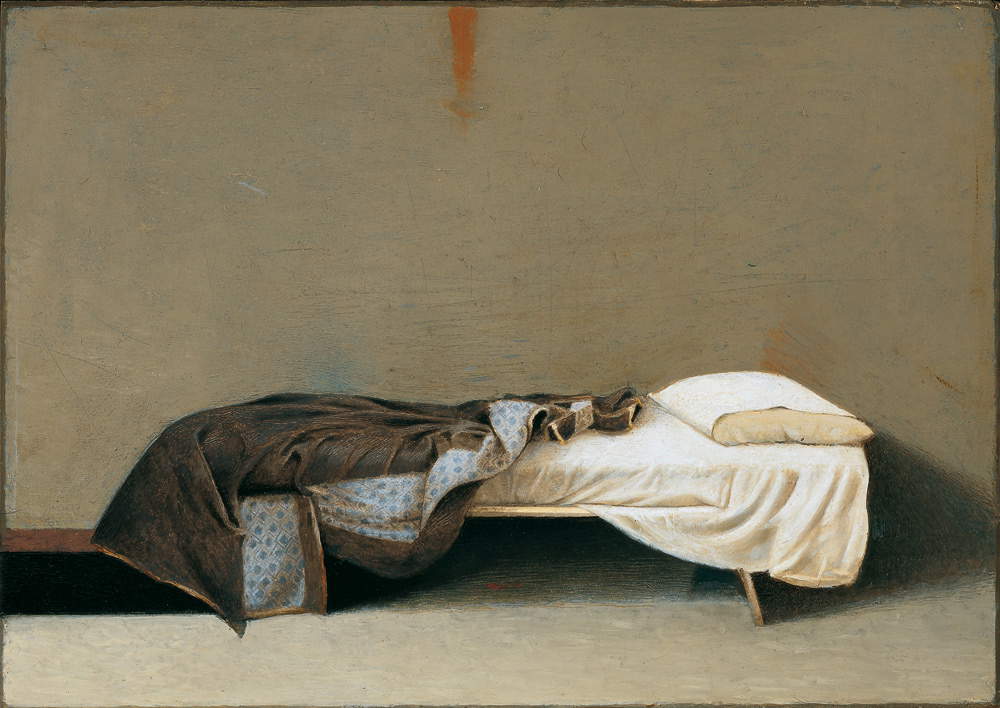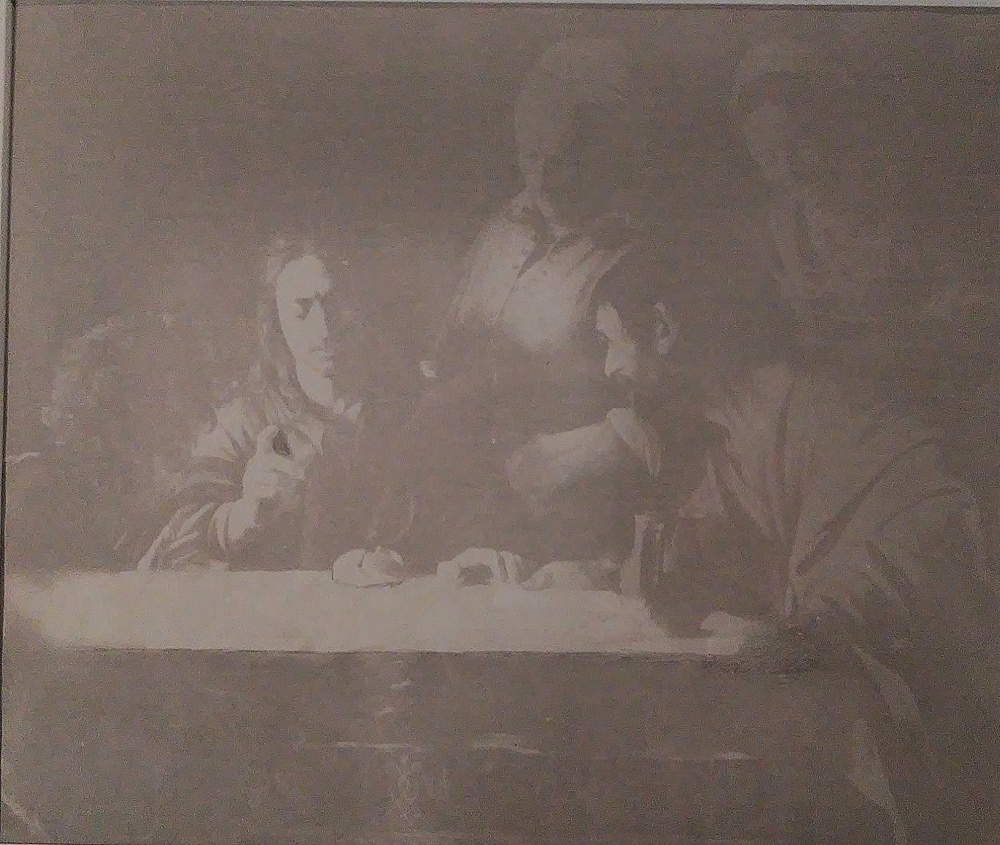by Federico Giannini (Instagram: @federicogiannini1), published on 17/08/2018
Categories: Exhibition reviews
/ Disclaimer
Review of the exhibition 'Gianfranco Ferroni. Before and after the Biennial of 68. Everything is coming to fruition', at the Palazzo Mediceo in Seravezza until September 16, 2018.
Everything is about to be accomplished. This is the title of one of the paintings with which Gianfranco Ferroni (Livorno, 1927 - Bergamo, 2001) participated in the 1968 Venice Biennale. An assortment of objects of different natures, detonators, the ever-present Star of David that embodied, at the time, the artist’s reflections on the tragedy of the Holocaust (which in his poetics became a symbol of universal evil), portraits, flags of different nations, signifying that the climate of fibrillating expectation that the artist intended to shape with his pop language, two-dimensional, inspired by suggestions from overseas but strongly internalized, should have invested the whole world. Denunciation and anxiety, then, but also confidence and expectations. Which, however, will be disregarded precisely during that edition of the Biennale, the edition that should have given substance to the change. It did not.
On June 18, 1968, theopening day ofthe Biennale, a multitude of students gathered in St. Mark’s Square to protest against the art of the bosses, against power, against police violence. That very violence, however, came down with full force on the students, who were charged and truncheoned in the great square of Venice. Nineteen out of the twenty-two Italian artists participating in the Venice Biennale that year devised a protest action, preventing the public from seeing their works: some covered them up, some hid them, some decided not to exhibit them. Ferroni decided simply to hang them with the recto facing the wall. However, almost all the artists returned to the ranks the next day: the protest was continued only by Gastone Novelli, Carlo Mattioli and Gianfranco Ferroni. The first two withdrew their works from the Biennale, while Ferroni decided to exhibit the works turned to the wall for the duration of the exhibition.
That event represented a kind of watershed in Ferroni’s career. Everything is coming to fruition: however, not in the way he perhaps intended and hoped. In Ferroni’s art there is a before and an after, and the ’68 Biennale is the boundary that divides what had been and what would be. His choice is now at the center of a major retrospective that takes its starting point precisely from that event, central to tracing Ferroni’s career in its entirety: it is entitled Gianfranco Ferroni. Before and after the ’68 Biennale. Everything Is About to Be Accomplished, is set up in the spaces of the Palazzo Mediceo in Seravezza until September 16, 2018, and is expertly curated by Nadia Marchioni. It is a systematic, precise exhibition on an artist who is not very easy (partly due to the fact that Ferroni is a painter who is little musealized: a large part of his masterpieces is still in private hands, and many of them still remain in the collections of those who were close to him when he was alive), and not particularly well known among the general public, despite the fact that critics and art historians of enormous stature had dealt with him (suffice it to mention the names of Testori and Ragghianti), of the fact that in his lifetime he was a highly esteemed artist capable of gathering around him generations of younger colleagues and influencing their poetics, and of the fact that he was the protagonist of several exhibitions held after his death (one even at the Uffizi). The Seravezza exhibition gives full account of Ferroni’s greatness by returning a complete itinerary through the various periods of an artist who, with extraordinary self-awareness, at a certain point in his life imagined (a case perhaps more unique than rare) anarticulated periodization of his entire artistic career.
 |
| Hall of the exhibition Gianfranco Ferroni. Before and after the ’68 Biennale. Everything is about to be accomplished |
 |
| Hall of the exhibition Gianfranco Ferroni. Before and after the ’68 Biennial. Everythingis about to be accomplished |
 |
| Gianfranco Ferroniexhibition hall. Before and after the Biennial of ’68. Everythingis about to be accomplished |
 |
| The room that commemorates the ’68 Biennale. |
 |
| Gianfranco Ferroni, Tutto sta per compiersi (1967; oil on canvas, 165 x 140 cm; Milan, Porro Collection) |
“My work is essentially divided into three periods,” Ferroni had occasion to declare to critic Davide Martinelli in 1998: “from 1955-1956 until ’62, from 1963 to ’70, from 1971 to the present. So in ’63-’64 a great change occurs.” But great changes are something inherent in Gianfranco Ferroni’s poetics: his is an art in constant evolution, it knows abrupt reversals of direction, sudden changes, sudden openings, decisive contrasts. When his career began, between the end of the 1940s and the beginning of the 1950s, Ferroni was still a young man profoundly marked by the Second World War: he did not participate in the wartime operations because his immature age had prevented him from doing so, but he was already old enough to feel the weight of the violence he had experienced. A weight that is evident, with all its burden of anguish, from his early compositions. It is precisely from the works of the 1950s that the Seravezza exhibition begins.
To those horrors evidently still alive and present before the artist’s eyes, was then added a difficult economic situation: having left his family in 1952 to move to Milan, where he would find a cultural environment that was certainly more stimulating than the one in Tradate where his family had moved during the war, Ferroni experienced poverty, but he still managed to carve out an important space for himself (he who, moreover, at just twenty-three, in 1950, had already been invited to exhibit at the Venice Biennale), to cultivate fruitful friendships, and to update his language on the highest models that Italian and European painting could provide him with at the time. His early manner is based on a markedly expressionist substratum: the works of the 1950s are characterized by somber hues spread with nervous and almost neurotic brushstrokes, ungainly and almost horrifying forms, faces disfigured by pain. The Blind Man Listening, a 1957 work, seems almost to have come out of one of Otto Dix ’s gloomy works on the theme of war atrocities, while the Sicilian Woman with a very angular face, pale, emaciated, exhausted and frazzled, is probably the most significant result of the trip to Sicily that Ferroni undertook in 1956, together with his colleague Tino Vaglieri: after that experience, Ferroni’s expressionism became increasingly dramatic, since, he explained, “the vision of an exploited, destitute humanity provokes on us a deep impression. Milan, with its problems of immigration, industrialization and capitalism (and coming consumerism) in comparison with these lands was a pleasant hell.” Ferroni is a profoundly sensitive artist, ever since he was a boy inclined to sympathize with the last ones and to put his human and artistic commitment at their disposal, so much so that, as a young man convinced of his political passion, he joined the PCI, except to tear up his membership in 1956, after the USSR bloodily suppressed the Hungarian uprising and the PCI sided with the Soviet Union (it was on that occasion that Togliatti had to say that “one stands with one’s own side even when it is wrong”). A disillusioned Ferroni produced, as a result of that experience, one of the fundamental works of his path, Violence, expressly dedicated to the events in Hungary: a body lying on the ground, bleeding, lifeless, to strike the relative with brutality.
 |
| Gianfranco Ferroni, Blind Listening (1957; oil on canvas, 70 x 60 cm; Private collection) |
 |
| Gianfranco Ferroni, Sicilian Woman (1956; oil on canvas, 105 x 75 cm; Private collection) |
 |
| Gianfranco Ferroni, Violence (1956-1957; oil on masonite, 76 x 102 cm; Bergamo, Ceribelli Collection) |
That was the first real turning point in Gianfranco Ferroni’s art, which after 1957 experienced a rapid paradigm shift. Some meditations that already, in a way, foreshadowed the future developments of his art and the need to access a more intimate and everyday reflection (see the still life Objects of 1958) were joined in Ferroni by an interest in the city: in his bird’s-eye views, mindful to some extent of the rooftops and informal landscapes of Nicolas de Staël, is substantiated “the obsession” (so Giacomo Giossi in his essay in the Seravezza exhibition catalog) “for the city, with its eccentric and sudden movements, with its teeming but also melancholic rhythms (Michelangelo Antonioni’s cinema Above all.” But it is about a city “not as a machine, but as an entangled body: a tired body, but always constrained within an obligatory yet vibrant movement.” A city that “explodes with its own signs that become engravings beyond the great lights of the studio.” A city that, in essence, is a kind of grand theater within which “the condition of man’s unease” is staged. An unease that Ferroni nevertheless wants to continue to bring out, including through the use of new modes of expression: the language of pop art is exploited to offer another image of that glittering world that various pop artists celebrated (or criticized) with their works. Warholian cans, in Ferroni, simply become Waste, the other face of that consumerism and capitalism which, speaking of the trip to Sicily, the artist identified as problems of the Milan in which he lived and worked.
Ferroni’s political commitment did not stop, then: only, it took different forms. This is the “great change” of ’63-’64 to which the artist alluded: “there is a period of years, which goes from ’63 to ’70,” he had occasion to declare in 1995 in an interview with the critic Claudio Nembrini, “where my work, my interest, becomes more politicized, and the participation is no longer tied to the self, but is tied to a historical situation, so the wounded Palestinian, the participation in what was happening in the Middle East. Where there was a man dying for an ideology, whatever it was, my participation was immediate, instinctive.” If up to that point Ferroni had indeed painted various human dramas, but which he had for the most part experienced firsthand, or to which he was otherwise close, from the early 1960s every tragedy that had taken place in any corner of the globe became in Ferroni a universal symbol of grief. Wounded Arab, painted in 1967, is a crude and decidedly explicit work, while a work such as Cognition of Guilt, made in 1965, stands as a reflection on the Holocaust which, as anticipated, is for Ferroni a symbol of universal evil: hence also the use of often employing the J motif in several works. The “J” is the initial of “Juden” in German (“Jews”), but it is also, as the artist himself explained (who, as we can easily guess by now, was always very keen to tell in the first person about his art), shaped like a hook, like an “iron entering the flesh.”
 |
| Gianfranco Ferroni, Objects (1958; oil on canvas, 46 x 79.5 cm; Private collection) |
 |
| Gianfranco Ferroni, City (1961; oil on canvas, 50 x 59.5 cm; Bergamo, Ceribelli Collection) |
 |
| Gianfranco Ferroni, Refuse (1964; oil on canvas, 52 x 47 cm; Private Collection) |
 |
| Gianfranco Ferroni, Wounded Arab (1967; oil on canvas, 136 x 113 cm; Private Collection, Courtesy Montrasio Arte) |
 |
| Gianfranco Ferroni, Cognition of Guilt (1965; oil on canvas, 137.3 x 173 cm; Private Collection, Courtesy Montrasio Arte) |
Then it was the turn of the 1968 Biennale, which was discussed at length in the opening. And for Ferroni it was perhaps the most bitter disappointment, capable of producing such disillusionment that he left Milan to find a more serene condition elsewhere: the aspirations of this period, between the end of the 1960s and the beginning of the 1970s, are all summed up in a work like Andare via, where Ferroni portrays himself, in a frontal position, as if he were looking at himself in a mirror to ask himself what to do now, after having realized that the struggle has lost its meaning. And exactly as Plinio Nomellini, another artist disappointed by the ineffectiveness of the cause in which he had believed, had done some eighty years earlier, Ferroni too found his refuge in Versilia: having left Lombardy, the Livorno-born artist returned to his home region, settling in Viareggio, where he spent his days playing cards, hanging out with the locals and people who were or were going to Versilia. For Ferroni it was a new beginning, which is exemplified in the exhibition by a painting like Albero: starting again from objects, from the intimate, from reality.
Ferroni was a completely new artist: an artist who, having matured in the awareness that it is difficult, if not impossible, to change things around him, and having definitively sanctioned the break with ideology, stopped looking outside and began to look inside himself. Ferroni liked to imagine this change as a form of atheism: one can be an atheist toward God, but also an atheist toward an ideology. The painter therefore began to focus, with almost manic obsessiveness, on the most mundane everyday objects. Doors, tables, easels, unmade cribs, studio interiors that Ferroni approaches with an inquiring spirit, to elevate the everyday, as Morandi had done before him, but also to try to grasp the profound mystery behind things, with an approach not unlike that of a De Chirico. The object itself is for Ferroni a mysterious entity, to which the artist is called to give new meanings. The dimension thus becomes that of expectation, as Ferroni himself, Andrea Zucchinali notes, “did not fail to emphasize several times in an unusual motion of sharing critical insights related to his work: I, a convinced layman, he said, am waiting for a miracle, for an apparition.” Waiting for an “event that he knows is impossible, and that will arise to make sense of the things that inhabit the limbic, suspended void in which we live.” Thus takes shape that painting where the protagonist “is memory, absence, loneliness,” but where “the description of reality, toward which the artist stands with a nonjudgmental and as acephalous as possible gaze, takes place according to an analytical method of incredible formal quality” (so Nadia Marchioni). And privileged tools for grasping the mystery become, by the artist’s own admission, space and light.
These ideas fascinated several young artists, who gathered around Ferroni by founding the Metacosa group. The reference was obviously De Chirico, the idea was to “observe the world with new eyes,” explains Nadia Marchioni, “in the hope of catching the moment when the mystery it holds is revealed, finally, to our gaze.” Each of the artists would then maintain his or her own style, but would not give up the idea of investigating reality in order to grasp that ineffable that they wanted to discover, in a sort of quest with mystical overtones but devoid of any religious connotation: and mysticism, stripped of its religious fanaticism, wrote Antonio Gnoli in his La luce dell’ateo, a 2009 volume that collected several of Ferroni’s writings, “is subtraction, erasure, progressive withdrawal from the world, a form of communicative absence.”
 |
| Gianfranco Ferroni, Andare via... (1968; oil on canvas, 105.5 x 102.7 cm; Bergamo, Ceribelli Collection) |
 |
| Gianfranco Ferroni, Tree (1972; oil on canvas, 110 x 84 cm; Bergamo, Ceribelli Collection) |
 |
| Gianfranco Ferroni, Closed Door (1974; mixed media on paper applied to canvas, 83.5 x 83 cm; Private Collection) |
 |
| Gianfranco Ferroni, Large Still Life (1982; mixed media on panel, 48 x 40 cm; Bergamo; Ceribelli Collection) |
 |
| Gianfranco Ferroni, Analysis of a Floor. Milan (1983; mixed media on paper, 43.4 x 41.4 cm; Private collection) |
 |
| Gianfranco Ferroni, Lettino (1984; oil on panel, 29.5 x 41.3 cm; Private Collection) |
From such reflections also matures the idea of reconnecting with the greats of the past. Privileged medium in this case is photography, to which the catalog devotes an extensive and lengthy contribution, in the form of a dialogue, by Marco Vallora and Alessio Zucchinali. At Palazzo Mediceo, however, it is possible to find several works that Ferroni made with this medium and which are exhibited for the first time to the public. In an attempt to understand photography according to Ferroni, it is possible to start from a shot that the artist took at the Pinacoteca di Brera, focusing on Caravaggio’s Supper at Emmaus: the image imprinted on the film is the starting point “to then in the printing phase manipulate the luminous flux, reducing its impact on the three figures to the left of Christ, probably through the use of differentiated exposure times in the different areas of the image” (Zucchinali). The end result is a kind of “conversion of the light beam coming from the left side of the representation into a singular frontal light,” which will serve Ferroni in the pictorial transposition,Homage to Caravaggio, where Christ is alone, in front of the table, with only the bread in front of him. The Emmaus Supper was, in fact, transposed into that metaphysical dimension dear to Ferroni. And the artist would later do the same with the Vocation of St. Matthew: here, too, characters removed, light the only protagonist to give shape to things.
But it would be reductive to limit Ferroni’s photography to the above. Like his painting, his photography feeds on absence. His photographs are “the framework of an intimacy that becomes a work of art” (Giossi), they are experiments with which Ferroni follows up on his intention to investigate reality in depth in order to grasp that mystery that he will never be able to shatter (and he is convinced of this himself), they are means with which Ferroni helps himself to see: but in his photographs the substance seems almost faded, blurred, to the point that often nothing can be seen in them anymore. Everything remains suspended, waiting for that miracle that Ferroni waited for but knew full well would never come.
 |
| Gianfranco Ferroni, Supper at Emmaus, from Caravaggio (s.d.; photograph; Private collection) |
 |
| Gianfranco Ferroni, Homage to Caravaggio (Supper in Emmaus) (1996; mixed media on cardboard, 25 x 23.55 cm; Private collection) |
 |
| Gianfranco Ferroni, Homage to Caravaggio (The Calling of St. Matthew) (1991; mixed media on paper, 28 x 36.8 cm; Private collection) |
A thick anthological exhibition, Gianfranco Ferroni. Before and After the ’68 Biennial. Tutto sta sta per compiersi restores the importance of this great artist, admittedly little known to the general public, with a dense, complete itinerary, consistent in its chronological unraveling, precise in giving an account of all the evolutions of his art, intelligent in communicating the essence of Ferroni’s art by interspersing, with the works, excerpts from his writings or interviews. A painter who sought to transfigure the real in order to get closer to an idea (and who therefore used his almost hyperrealist forms not to describe but to imagine), a man full of doubts, an author who went looking for (and finding) his metaphysical visions in the everyday, Ferroni never made a secret of experiencing precisely in waiting his role as an artist. “The meaning I give to my being today as an artist lies in waiting, a sacred waiting, because sacred is the desire to have a revelation, and although I know it will not come to me, I look for it. I expect a meaning that still eludes me, a meaning that goes beyond my life.”
Warning: the translation into English of the original Italian article was created using automatic tools.
We undertake to review all articles, but we do not guarantee the total absence of inaccuracies in the translation due to the program. You can
find the original by clicking on the ITA button. If you find any mistake,please contact us.
